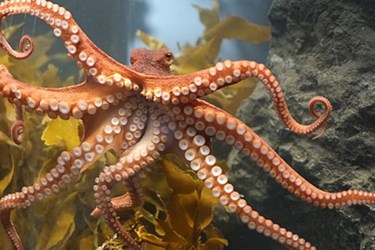What Octopus Arms Can Teach Us About Surgical Robot Design
By Joel Lindsey

A new study of octopi, conducted by researchers at the Hebrew University of Jerusalem, could provide new ideas for improving bio-inspired robots for use in medical applications.
The study, published recently in the journal Current Biology, details the research team’s efforts to understand how octopi avoid getting tangled up in their own long, flexible, suction cup-lined arms.
In the absence of a mental structure that maps and controls the precise location of each of its limbs, an octopus relies on a specialized chemical to avoid sticking to itself and becoming entangled in its own arms, researchers have concluded.
“The results so far show, and for the first time, that the skin of the octopus prevents octopus arms from attaching to each other or to themselves in a reflexive manner,” researchers said in a recently published press release. “The drastic reduction in the response to the skin crude extract suggests that a specific chemical signal in the skin mediates the inhibition of sucker grabbing.”
Although researchers have yet to precisely identify the active agent in octopi’s self-avoidance behavior, those involved with the project believe they have discovered an important component of the animal’s overall intelligence.
This particular behavior may also provide valuable insights for those working to develop medical-related robotic devices, researchers say.
“Soft robots have advantages [in] that they can reshape their body,” said Nir Nesher, researcher and co-first author of the study. “This is especially advantageous in unfamiliar environments with many obstacles that can be bypassed only by flexible manipulators, such as the internal human body environment.”
According to the press release, researchers are sharing their new findings with the European Commission’s STIFF-FLOP project, which is working to create a flexible surgical manipulator in the shape of an octopus arm.
“We hope and believe that this mechanism will find expression in such new classes of robots and their control systems,” said Binyamin Hochner, another researcher involved with the study.
Other bio-inspired designs have been making headlines recently. Most notably, Med Device Online published a story about new adhesive devices modeled after the construction of spider webs.
Similarly, a new report from the American Urological Association’s annual conference highlights the capabilities of dogs to sniff out and detect the presence of cancer — a capability many hope could translate into more effective cancer detecting devices.
